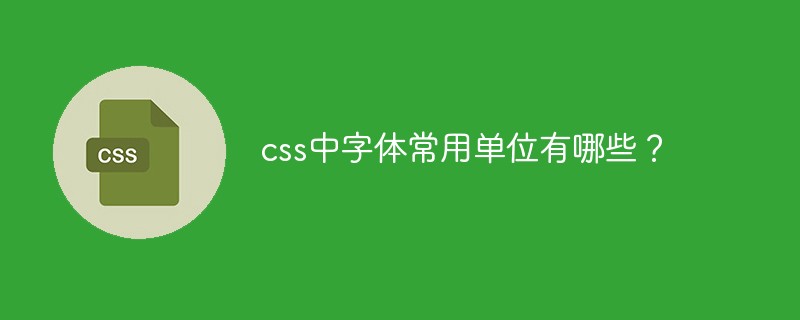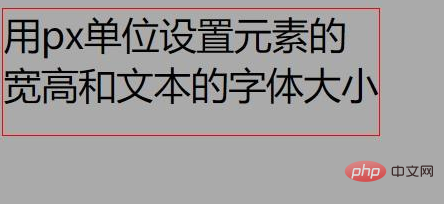What are the commonly used units for fonts in CSS?
Commonly used units for fonts in css are: 1. px (pixel), which is a unit of fixed size; 2. em, which is a relative length unit, relative to the font size of the parent element; 3. rem, which is a relative length unit , is the font size relative to the root node (or html node); 4. %, relative length unit, relative to the parent element.

The operating environment of this tutorial: Windows 10 system, CSS3, this article is applicable to all brands of computers.
Related recommendations: "CSS Video Tutorial"
1. Commonly used units for fonts in css are px, em, rem and %
1. px (pixel)
The name of the px unit is pixel, which is a unit of fixed size. The calculation of pixel is for (computer/mobile phone ) screen, a pixel (1px) is a point on the (computer/mobile phone) screen, that is, the minimum division of the screen resolution. Since it is a unit of fixed size, if a webpage designed with it alone is adapted to a large screen (computer), it will be very unfriendly on a small screen (mobile phone) and cannot achieve the adaptive effect.
Example:
nbsp;html>
<meta>
<title>css px像素固定长度单位</title>
<style>
body{background-color: #aaa;}
.px{border:1px solid red;width:300px;height:100px;font-size:30px;}
</style>
<div>
用px单位设置元素的宽高和文本的字体大小
</div>
Run result:

##2, em (relative length unit)
The em unit is also commonly used, especially abroad; the name of the em unit is a relative length unit, which is used to set the font size of the text, relative to the font size of the text in the parent element object; if there is no artificial Sets the font size of the text within the current object, so it is relative to the browser's default font size (16px). Example:nbsp;html>
<meta>
<title>用em相对长度单位来设置文本的字体大小</title>
<style>
body{background-color: #aaa;}
.div{border:1px solid red;width:300px;height:100px;font-size:30px;}
.em{font-size:0.5em;}/*30px x 0.5 = 15px*/
</style>
<div>
<span>用em相对长度单位来设置文本的字体大小</span>
</div>

3. rem (new relative length unit in css3)
Rem is a new relative length unit in CSS3. It appears to solve the shortcomings of em. Em can be said to be the font size relative to the parent element. When the font size of the parent element changes, it must be recalculated. The emergence of rem can solve such problems. rem is only relative to the root node, which is the HTML element. So as long as the font size is set on the html tag, the font size in the document will be based on this reference standard, which is generally used for adaptive layout.nbsp;html>
<meta>
<title>用css3新增的相对长度单位rem来设置文本的字体大小</title>
<style>
body{background-color: #aaa;}
.div{border:1px solid red;width:300px;height:100px;font-size:30px;}
.rem{font-size:0.5rem;}/*16px x 0.5 = 8px*/
</style>
<div>
<span>用rem相对长度单位来设置文本的字体大小</span>
</div>
4. % (percentage)
% is also very common. It is almost the same as em, both Relative to the parent element. But % can be used in many attributes, such as: width, height, font-size, etc. Em is the unit used to set the font size (font-size). Properties such as width and height do not have em units.2. The difference and summary of px, em, rem and %
- px is a fixed length unit and does not change randomly. Changes with changes in other elements;
- em and % are units relative to the parent element and will change with changes in the properties of the parent element (font-size or other attributes);
- rem is relative to the root directory (HTML element), so it will change with the attribute (font-size) of the HTML element;
- px and % are more widely used and can serve as units for more attributes, while em and rem are units for font size and are used as units for the font-size attribute
- Generally speaking: 1em = 1rem = 100% = 16 px
Programming Video! !
The above is the detailed content of What are the commonly used units for fonts in CSS?. For more information, please follow other related articles on the PHP Chinese website!

Hot AI Tools

Undresser.AI Undress
AI-powered app for creating realistic nude photos

AI Clothes Remover
Online AI tool for removing clothes from photos.

Undress AI Tool
Undress images for free

Clothoff.io
AI clothes remover

AI Hentai Generator
Generate AI Hentai for free.

Hot Article

Hot Tools

Notepad++7.3.1
Easy-to-use and free code editor

SublimeText3 Chinese version
Chinese version, very easy to use

Zend Studio 13.0.1
Powerful PHP integrated development environment

Dreamweaver CS6
Visual web development tools

SublimeText3 Mac version
God-level code editing software (SublimeText3)

Hot Topics
 1385
1385
 52
52
 How to use bootstrap in vue
Apr 07, 2025 pm 11:33 PM
How to use bootstrap in vue
Apr 07, 2025 pm 11:33 PM
Using Bootstrap in Vue.js is divided into five steps: Install Bootstrap. Import Bootstrap in main.js. Use the Bootstrap component directly in the template. Optional: Custom style. Optional: Use plug-ins.
 The Roles of HTML, CSS, and JavaScript: Core Responsibilities
Apr 08, 2025 pm 07:05 PM
The Roles of HTML, CSS, and JavaScript: Core Responsibilities
Apr 08, 2025 pm 07:05 PM
HTML defines the web structure, CSS is responsible for style and layout, and JavaScript gives dynamic interaction. The three perform their duties in web development and jointly build a colorful website.
 How to write split lines on bootstrap
Apr 07, 2025 pm 03:12 PM
How to write split lines on bootstrap
Apr 07, 2025 pm 03:12 PM
There are two ways to create a Bootstrap split line: using the tag, which creates a horizontal split line. Use the CSS border property to create custom style split lines.
 Understanding HTML, CSS, and JavaScript: A Beginner's Guide
Apr 12, 2025 am 12:02 AM
Understanding HTML, CSS, and JavaScript: A Beginner's Guide
Apr 12, 2025 am 12:02 AM
WebdevelopmentreliesonHTML,CSS,andJavaScript:1)HTMLstructurescontent,2)CSSstylesit,and3)JavaScriptaddsinteractivity,formingthebasisofmodernwebexperiences.
 How to resize bootstrap
Apr 07, 2025 pm 03:18 PM
How to resize bootstrap
Apr 07, 2025 pm 03:18 PM
To adjust the size of elements in Bootstrap, you can use the dimension class, which includes: adjusting width: .col-, .w-, .mw-adjust height: .h-, .min-h-, .max-h-
 How to set up the framework for bootstrap
Apr 07, 2025 pm 03:27 PM
How to set up the framework for bootstrap
Apr 07, 2025 pm 03:27 PM
To set up the Bootstrap framework, you need to follow these steps: 1. Reference the Bootstrap file via CDN; 2. Download and host the file on your own server; 3. Include the Bootstrap file in HTML; 4. Compile Sass/Less as needed; 5. Import a custom file (optional). Once setup is complete, you can use Bootstrap's grid systems, components, and styles to create responsive websites and applications.
 How to insert pictures on bootstrap
Apr 07, 2025 pm 03:30 PM
How to insert pictures on bootstrap
Apr 07, 2025 pm 03:30 PM
There are several ways to insert images in Bootstrap: insert images directly, using the HTML img tag. With the Bootstrap image component, you can provide responsive images and more styles. Set the image size, use the img-fluid class to make the image adaptable. Set the border, using the img-bordered class. Set the rounded corners and use the img-rounded class. Set the shadow, use the shadow class. Resize and position the image, using CSS style. Using the background image, use the background-image CSS property.
 How to use bootstrap button
Apr 07, 2025 pm 03:09 PM
How to use bootstrap button
Apr 07, 2025 pm 03:09 PM
How to use the Bootstrap button? Introduce Bootstrap CSS to create button elements and add Bootstrap button class to add button text





